Another Look at the Clearwater Voltage Sentry
We first reviewed the original Clearwater Voltage Sentry in September 2011.
It was installed on the Suzuki DR650SE (Blog), which was the webBikeWorld Project Bike that year in the “Budget Adventure Touring” series.
Since the, a Clearwater Voltage Sentry (aka CVS) has been installed on every new Project Bike and recent updates prompted this second look.
It’s a “must have” accessory and one of the first to be installed on any new bike, along with a new louder horn and conspicuity lights.
The CVS is very small, very light, easy to install and everything is completely hidden, other than the all-important LED.
The LED uses the familiar “red/amber/green” lighting method to let you know at a quick glance if everything is OK with your motorcycle’s charging system.
Yes, there are plenty of other Volt meters and lights you can use on your bike and we’ve tried a few, like the Show Chrome Digital 5-Function Motorcycle Volt Meter (review).
But the Clearwater Voltage Sentry is about the simplest there is and it’s extremely accurate, using an internal CPU (computer) to measure down to a claimed 0.25% change in your battery’s Voltage.
The most important feature is that the CVS works all the time, both when your bike is parked in the garage for weeks or months and when you’re out riding. Other analog or digital Voltmeters work only when the bike is running.
Forget analog gauge type Volt meters; they’re too hard to read and the printed line calibrations can be off by a mile.
With the CVS, green means good and that’s all you need to see or know. It’s super quick and very reliable.
If the battery starts to discharge or the Voltage changes up or down, you’ll get a warning light from the LED on the Clearwater Voltage Sentry. It’s called a “Sentry” because that’s what it is; continuously monitoring the battery charge, whether the bike is on or off.
This is especially important on today’s motorcycles, with their many electronic gizmos constantly draining the battery, whether the bike is parked or not.
And don’t forget smaller bikes or the less sophisticated types, like the Suzuki DR650SE (Blog) or even the new 2015 Kawasaki Versys 650 LT (Blog).
They don’t have an over-abundance of battery power to begin with, so it’s important to know whether or not you’re over-drawn in the juice department with heated grips, lights, GPS devices and the rest.
In fact, the Versys 650 alternator outputs just 336 Watts at 5,000 RPM (24 Amps, 14 volts at 5,000 RPM) and the standard load when the bike is running (lights, fuel injection, computer, fan, etc.) is around 285 Watts.
That doesn’t leave much juice left for accessories and the Clearwater Voltage Sentry is an important device that will warn you if the battery is going into a deficit.
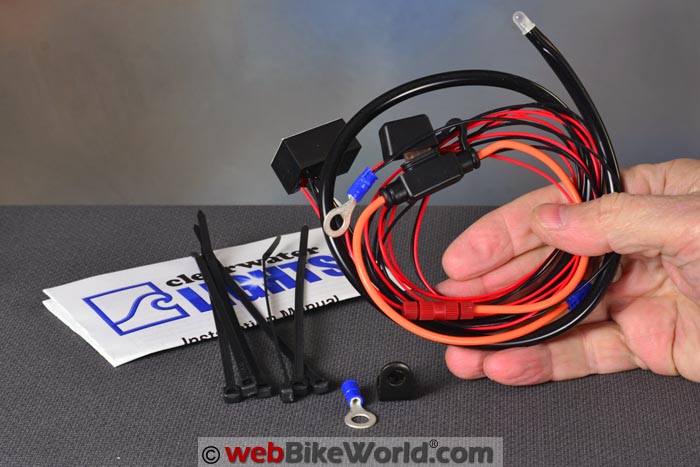
Clearwater Voltage Sentry Updates
The new CVS doesn’t work any differently than the original, so be sure to read our original Clearwater Voltage Sentry review from 2011.
However, Clearwater Lights has made some running updates to the CVS during this time. Besides improving the LED interface, the CVS module is now smaller, with updated firmware and it can also be used with the popular Shorai battery (review), which has a fairly narrow and specific Voltage range.
The new CVS should also be usable with other LiFePo batteries, like the Ballistic Lithium Iron Phosphate batteries (review).
A version of the CVS (the dual battery version with two LEDs) is also used by various police departments to monitor the two batteries on their motorcycles, used for powering the bike and for accessories like lights, radio, sirens, computers, etc. A marine version is also available.

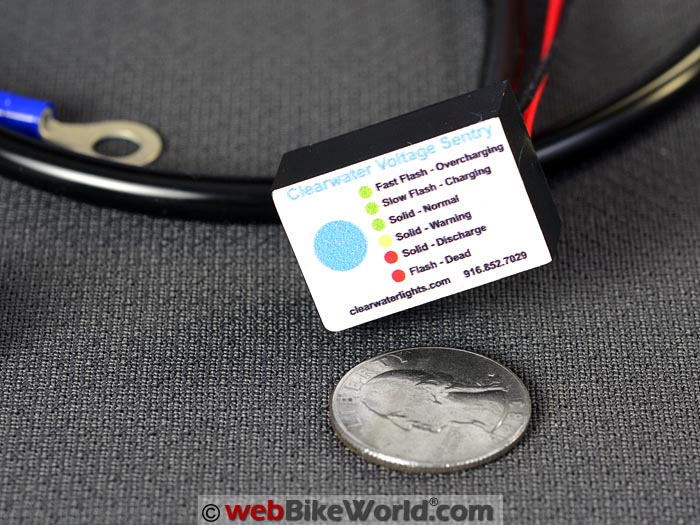
Where to Buy Clearwater Voltage Sentry
Check Reviews & Prices on AmazonAlso Shop for: LED Lights and Bulbs, Auxiliary Driving Lights, Motorcycle LED Headlights
Wiring the CVS
One of the cool things about the CVS is that it’s so simple to install. It doesn’t need any connection to a special wire, computer or anything else on the bike.
The only connections are a power and ground. The power (red/orange) lead has an 18-24 Posi-Lock attaching a short harness with a 5 Amp fuse. The power lead can be connected directly to the battery or the fuse section can be removed if the power lead is connected to a fused, always-on wire.
The black lead is connected to the negative (ground) terminal on the battery.
We always connect directly to the battery, with the ground wire to the negative terminal and the power lead to the positive terminal.
How It Works
Clearwater says that it is designed to operate in a temperature range of -40 F to over 200 F (-40C to 100C).
Once it’s connected, the microprocessor in the CVS constantly monitors the battery Voltage, whether the bike is running or not. As soon as it senses any change in Voltage, the LED will turn on.
To simplify, all you have to remember is “green is good”, as Clearwater says; yellow is a warning and red is danger. Just like a stop light. For the vast majority of the time, the LED will show green, either a solid or slow blinking.
Occasionally you’ll get a yellow, if you turn the ignition on and the various lights and accessories before starting the bike and the alternator isn’t running at a high enough speed to get the battery out of deficit.
Also, on some bikes like the DR650 and Versys 650, the LED will show solid green until the revs come off idle.
The LED will either show solid or blinking colors as follows:
- Fast Flashing Green: Very rare, overcharging condition, check the alternator and or voltage regulator. Over 14.6 Volts or over 14.8V with Shorai.
- Slow Flashing Green: Normal when riding and is the most common LED indication (and the one you want to see) and it means that the battery is charging correctly. It indicates 13.2 to 14.6 Volts (13.5 to 14.8 Volts with Shorai battery).
- Solid Green: Indicates a good battery condition with the bike off but a poor to weak charging condition with the bike running. This can also indicate your accessories are drawing too much power. Sometimes happens at idle until the engine is revved. Indicates 12.5 to 13.1 Volts (13.2 to 13.4 Volts on Shorai battery).
- Solid Yellow: Battery needs recharging, either start the bike and run it past idle or if the LED shows yellow while the bike is running, it means you are drawing more power than the alternator is generating (or possibly a defective alternator). Indicates 12.1 to 12.4 Volts (12.9 to 13.1 Volts for Shorai).
- Solid Red: Weak battery, start and run the engine for a while or connect a charger. If this persists after charging, the battery needs to be replaced. If this occurs while the bike is running, your alternator is bad or severely overloaded. Indicates 11.6 to 12.0 Volts (12.7 to 12.8 Volts on Shorai).
- Flashing Red: Indicates a “flat” or defective battery. Indicates less than 11.5 Volts (12.7 Volts on Shorai).
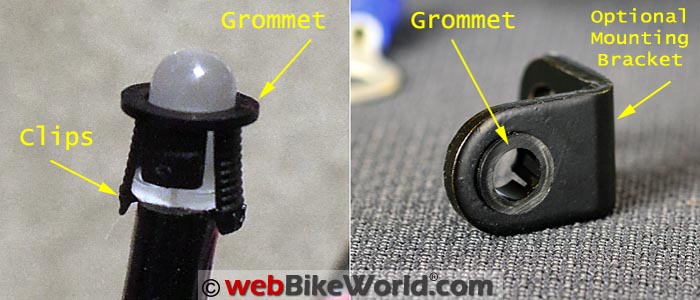
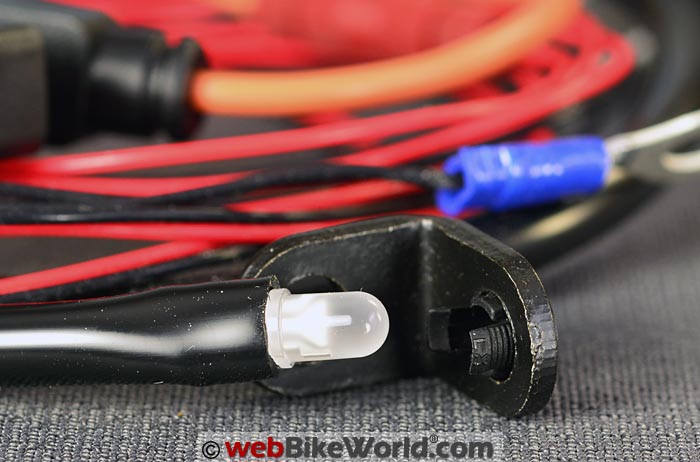
Where to Buy Clearwater Voltage Sentry
Check Reviews & Prices on AmazonAlso Shop for: LED Lights and Bulbs, Auxiliary Driving Lights, Motorcycle LED Headlights
Mounting the CVS
We’ve been pretty sloppy with the CVS installations in the past, by simply zip-tying the LED to any handy upright on the handlebar. The kit comes with an “L” shaped plastic bracket and a mounting grommet for the LED.
The grommet slips over the end of the LED and two small arms on the grommet have little nubs that catch the back of the plastic ring at the base of the LED, holding the LED in place in the grommet. The grommet can then be pushed into the L shaped bracket.
But this time, we decided to go professional and flush mount the LED on the dashboard of the Versys by drilling a hole and using the grommet for the flush mount (see the photo at the top of the page or the video below for the results).
This is easy to do on the Versys 650 because the black front panel on the top of the fairing is easily removed, which then provides access to the back of the instruments and the panel molding.
Be sure to “Measure twice, cut once”, as the saying goes. It’s usually best to drill a small pilot hole first, to prevent a larger drill bit from “walking”. The grommet needs a 6 mm (1/4″) hole, so we first drilled a hole with a 1/16″ drill bit, then used the 1/4″ bit to bring it to size.
Try to hold the drill as close to perpendicular to the surface as possible to ensure a true hole. The plastic on the dashboard is pretty soft, so it doesn’t take much pressure at all and the bit is through.
Once that was done, we cleaned up the front and back of the hole with a small round file with fine grade teeth.
Push the LED cable through from the rear of the hole, attach the grommet and carefully push the “legs” of the grommet back through the hole. We then used some silicone adhesive gobbed on the rear as a safety to hold it in place.
A hot glue gun would probably work but we couldn’t fit the tip of the glue gun behind the panel on the Versys.
As you can see, it’s a very nice and clean “factory look” installation and an unexpected bonus is that the LED light reflects slightly on the raised portion of the dashboard, as you can see in the video.
Original vs. New Clearwater Voltage Sentry
The original Clearwater Voltage Sentry control module or CPU/microprocessor measured 38 mm wide by 32 mm tall by 19 mm thick. The updated version measures just 30 mm by 15 mm by 20 mm.
You don’t need to see the CPU, so it’s not necessary to locate or mount it anywhere visible. You only need to see the LED.
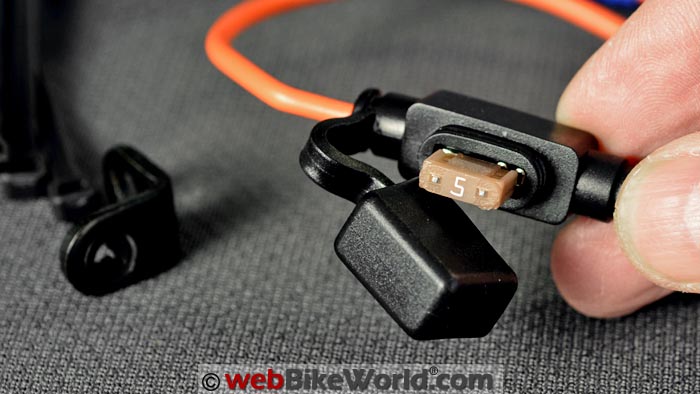
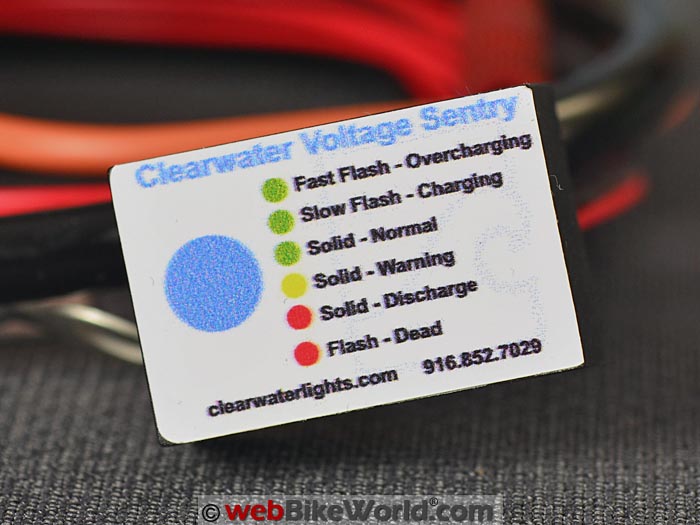
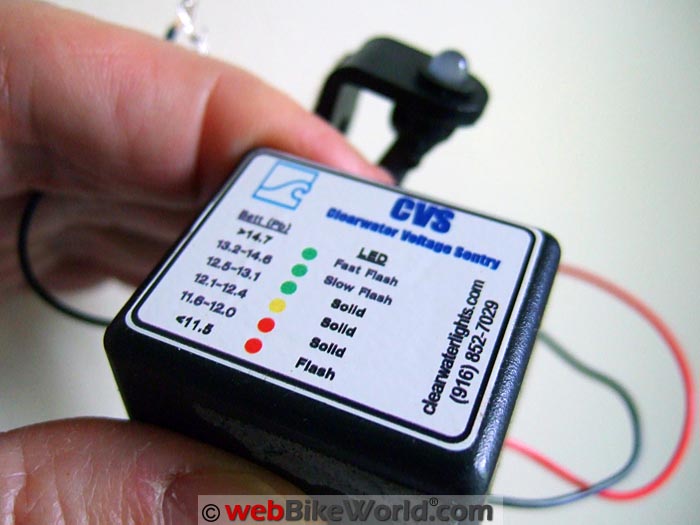
Conclusion
The Clearwater Voltage Sentry is another “must have” device that is especially useful on smaller motorcycles with marginal electrical capacity. That includes our new 2015 Kawasaki Versys 650 LT, with its meager 336 Watt alternator output.
The CVS is easy to install, requiring just a power and ground connection to the battery or to any other “always on” power lead and a ground point.
The CPU can be hidden anywhere on the bike and the only thing necessary is to have the LED located so that it can be viewed by the ridre.
The LED light color sequence may seem a bit confusing, but it really isn’t Just remember that slow flashing green is good.
That’s the light you will most likely see when you’re riding. If you see solid green, yellow or red, something’s wrong with your bike’s electrical system.
We’re convinced that the LED light warning system is better than a digital or analog gauge and Clearwater also claims the CVS is highly accurate. And the best part is, the $59.00 price hasn’t changed in 5 years.
| wBW Review: Clearwater Voltage Sentry | |
|---|---|
| Manufacturer: Clearwater Lights | List Price: $59.00 |
| Colors: N/A | Made In: U.S.A. |
| Review Date: February 2016 | |
Note: Item provided by a retailer, distributor or manufacturer with these Terms and Conditions.
Where to Buy Clearwater Voltage Sentry
Check Reviews & Prices on AmazonAlso Shop for: LED Lights and Bulbs, Auxiliary Driving Lights, Motorcycle LED Headlights
Owner Comments and Feedback
See details on submitting comments.
From “M.M.” (May 2017): “In the article it is listed that the product is wired to the battery for an always on setup.
Does this product have a significant power draw where the battery would be drained after a short period since this is constantly drawing power?
How long would the bike sit before it would need to be connected to a charger do to the always on state?”
Rick’s Reply: Good question, the whole idea of the CVS is to constantly monitor the battery and display any issues via the LED.
Clearwater says “The computer uses only microamps of current to perform this ‘sentry’ duty. Far more power is lost in the battery due to natural self discharge.”
So it takes very little power and the beauty of it is that even if the bike is sitting there for weeks, the LED will turn on if the battery voltage changes to let you know what’s happening.
The CVS has become a standard item on all my bikes, it’s especially nice with the flush mounting we did on the Versys, I watch the LED all the time to note if there are any changes to the somewhat weak electrical system on that bike.
From “M.H.” (March 2016): “Great review of the product. I was reaching for my wallet until I watched the video and it confirmed that flashing green is the normal state for the charging system and battery.
I disagree with Clearwater’s logic: I would never install a product that had a flashing light for a normal state. It looks like on the previous generation CVS, solid green is normal, and that I would agree is correct logic.”
Rick’s Reply: I don’t know what the logic is behind having the light flash in the normal state, but to be honest, it simply isn’t an issue.
No offense, but I’ve received quite a few emails and YouTube comments about the flashing light, mostly from who don’t own the product, haven’t used it and have never seen one.
I’m not sure why so many people seem obsessed with the flashing light issue; perhaps it’s because of our video, which shows the light in close-up and in dim light to enhance the effect.
But honestly, I’ve been using the CVS on several bikes for a few years and it’s a fantastic and accurate method to monitor the battery and charging performance at all times. Believe me, a tiny flashing LED is not an issue. I think of it like a heartbeat — it’s slowly flashing, letting me know everything is fine.
From “D.H.” (February 2016): “Thank you for all of your reviews. They always strike me as thorough and unbiased.
I like the idea of the Voltage Sentry on my DR650 for the reasons you’ve stated. It takes up no space and it’s waaaay to easy to overcharge the system on this bike.
My only thought and it is an important one to me is that the flashing green in a normal state of charge is very distracting. Don’t even think of mounting it next to you signal indicator!
I’m not sure what they’re reasoning may have been, but I feel it’s worth mentioning.”
Clearwater’s Response: In order to provide enough “levels” of indication with only a single LED, flashing green was chosen. The green should only flash slowly when the alternator is providing a good charge. It should go to solid green with a good battery and the engine is off.
But, the “window” of voltage where the LED goes from solid to flashing is pretty narrow, especially for a Shorai (or similar) battery. The resting voltage of a Shorai can be close to what some alternators produce. The difference between resting and charging is small.
Very new Shorai batteries can display a flashing green after the engine is off for a little while.
As far as the brightness, one could put a small cover or simply mount the LED to a control cable and have it be off angle to the eye. In order to suit everybody’s desires, we would have to offer a programmable version. But then, customer support might be an issue.
From “F.F.” (February 2016): “My concern for all multi-filament LED systems is that they are not very useful for people that are color blind (especially red/green) which by some estimates is 10% of the male population in the U.S.
Anyway, I cannot distinguish the red and green hues on these types of systems. It would be helpful if there was some feedback from a color blind person when testing systems that rely on multi-filament LEDs.”
From “R.L.” (February 2016): “I noticed your YouTube and website entry on the Clearwater Voltage Sentry. I have been using their solution (and the one specially made for Shorai LiFePo4 battery, apparently discontinued nowadays) for well over a year. I love it to bits, as it indeed gives a good quick view of the battery-status.
However, 2 points I would like to make:
The LED is quite bright in the evening/night, next to the fact that the flashing might be a wee bit distracting. I have installed it on the side of my fuel tank-rail (on my BMW R1200RT), so I can see it in any instance, even when parked. I personally therefore would not recommend it to be installed into the direct view of the rider.
The LED is not much protected other than from the tubing, my LED broke one of its pins within a week or so. I strongly recommend using a (Radio Shack?) LED holder to ensure mechanical strengths and vibrations. Or use a fair amount (blob) of silicone glue to encapsulate its end.
The LED used is the Everlight MV5439A with a common Cathode, which is a wee bit uncommon compared to other applications where bi-colour LED’s are being used.
PS: As always, Clearwater’s support is more then excellent and it is quite an accurate/spot-on solution. Unlike some of the solutions of other vendors, including panel instruments.”
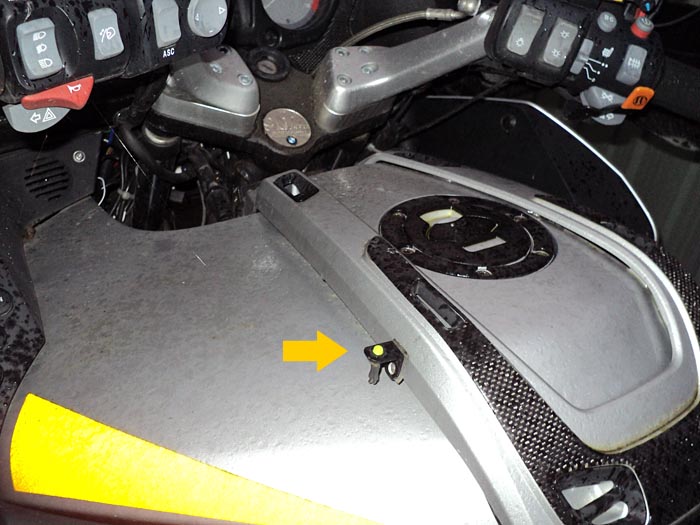
Other WebBikeWorld Motorcycle Lighting Reviews



Another great review from WBW, thank you. I have a couple of the Clearwater voltage monitors mounted and they have been solid (and no, the light is not in anyway distracting).
My only complaint is they are pretty expensive for what you are getting and I see competing products for half the price – tough do not know how they hold up such as the Head’s Up™ Voltage Monitor.